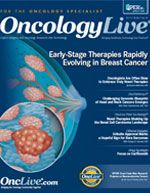Publication
Article
Oncologists Are Often Slow to Embrace Truly Novel Therapies
Author(s):
The delivery of antineoplastic therapy via the intravenous route is a long-standing, critical, and well-coordinated component of oncology practice. But what happens when a novel treatment strategy is introduced into the oncology arena that challenges this traditional drug infusion paradigm?
Maurie Markman, MD
One of the most important activities of a medically trained oncologist is organizing the administration of antineoplastic drug therapy. While certain medications are delivered orally, including many hormonal treatments and an increasing number of molecularly targeted therapeutics, systemic drug delivery has for decades served as the backbone of most medically oriented oncology practices.
Patients may receive treatment in an individual physician office, an infusion center run by a group, or an outpatient or inpatient hospital setting. The nurses, technicians, pharmacists, and other personnel who work together may be employees of the physician’s practice, a hospital, or an independent infusion center.
Although the drugs, infusion times, and schedules may change, the delivery of antineoplastic therapy via the intravenous route is a long-standing, critical, and well-coordinated component of oncology practice.
Ovarian Cancer Example
Oncology care providers do not seem to have any trouble adapting to change in this area. But what happens when a novel treatment strategy is introduced into the oncology arena that challenges this traditional drug infusion paradigm? Clearly, in the research setting, some oncologists may enthusiastically elect to participate in individual trials while others (as is the case with research in general) may decline this opportunity.How, then, can research advances be translated into broad clinical practice? Specifically, what is the appropriate response by oncologists when phase III randomized trial data reveal an improvement in a highly clinically relevant outcome associated with a truly new approach to cancer management that is not based on intravenous infusion or an oral approach? Under these circumstances, should all individual oncology practices learn how to effectively administer such therapy?
Consider the experience with intraperitoneal cisplatin- based chemotherapy delivery in the management of small volume residual advanced ovarian cancer following primary surgical cytoreduction.1,2
Three large, well-designed phase III randomized trials conducted by a National Cancer Institutecooperative group have revealed that use of this route of administration improves overall survival in this clinical setting compared with intravenous cisplatin.1 However, rather extensive data have documented the unquestionably disconcerting fact that only a small fraction of women who are potential candidates for this strategy are actually treated with this solidly evidence-based approach.2
The critical question is, why?
While a number of possible reasons can be advanced (including the toxicity of cisplatin compared with carboplatin), it is reasonable to suggest that the lack of familiarity and limited experience with this strategy as well as a critical absence of necessary infrastructure within a given practice setting to administer therapy by this route plays a major role in the most unfortunate decision to not offer patients a treatment that has been shown to potentially improve survival outcomes.
Further, it may be the feeling of some (or many) oncologists that there is not sufficient financial compensation for the additional time, effort, and training required to successfully deliver chemotherapy by the intraperitoneal route.
Recent Advances May Face Barriers It is interesting to note that while the issues surrounding the administration of intraperitoneal chemotherapy have been evident for several decades, there are more recent additions to the cancer management armamentarium where similar questions regarding experience as well as the required training and effort will likely weigh heavily in the decision by an individual oncologist or group to employ the novel approach in routine oncologic practice.
Talimogene laherparepvec is a novel herpes simplex virus oncologic immunotherapy that has been shown to favorably impact time to disease progression and improve survival in a highly select group of patients with unresected stage IIIB, IIIC, or IV advanced melanoma.3 The treatment requires intralesional injection of this novel product.
How will this antineoplastic approach actually be employed in routine practice, recognizing that the clinical indications are limited and alternative strategies such as systemic immunotherapy may be available? Will oncologists embrace the strategy, based on the phase III trial data and regulatory approval and attempt to employ the approach in their practices, or will they send patients who may benefit to a regional or academic center where there may be more experience, or perhaps even to another local practice where the approach is being employed? Or will oncologists simply elect to ignore the existing data, similar to what appears to be the situation with intraperitoneal chemotherapy for ovarian cancer, due to similar concerns about the time, effort, experience required, and limited financial compensation?
A final and perhaps even more provocative example of a novel therapy whose place in disease management remains to be defined is that of the use of tumor-treating fields in the management of malignant brain tumors.4 This concept calls for the use of low-intensity, intermediate-frequency (200 kHz) alternating electric fields delivered continuously (at least 18 hours per day) to the tumor bed by a device placed on the scalp. One phase III trial that combined this approach with temozolomide compared with temozolomide alone as therapy for glioblastoma revealed an improvement in both median progression-free survival (7.1 months vs 4.0 months, respectively; P = .001) and median overall survival (20.5 months vs 15.6 months, respectively; P = .004).4
Recognizing that malignant brain tumors are fortunately uncommon and that it is most unlikely any oncology practice outside of groups who may have been participants in clinical trials will have had experience with this technique, how will this novel approach be accepted in the routine care of patients in this difficult clinical setting? Perhaps optimal use of such a strategy might be for a limited number of practices in any given geographical area to become proficient with the technique and offer to assist other groups with patients requiring such therapy. Of course, the fundamental goal here will be to find a satisfactory mechanism that would permit patients with cancer to have the opportunity to take advantage of quite novel management strategies while at the same time appreciating the difficulties associated with requiring all practices to have the essential expertise to safely and competently deliver all such therapeutics.
References
- Markman M, Walker J. Intraperitoneal chemotherapy of ovarian cancer: a review with a focus on practical aspects of treatment. J Clin Oncol. 2006;24(6):988-994.
- Wright AA, Cronin A, Milne DE, et al. Use and effectiveness of intraperitoneal chemotherapy for treatment of ovarian cancer. J Clin Oncol. 2015;33(36):2841-2847.
- Andtbacka RH, Kaufman HL, Collichio F, et al. Talimogene laherparepvec improves durable response rate in patients with advanced melanoma. J Clin Oncol. 2015;33(25):2780-2788.
- Stupp R, Taillibert S, Kanner AA, et al. Maintenance therapy with tumor-treating fields plus temozolomide vs temozolomide alone for glioblastoma: a randomized clinical trial. JAMA. 2015;314(23):2535-2543.










